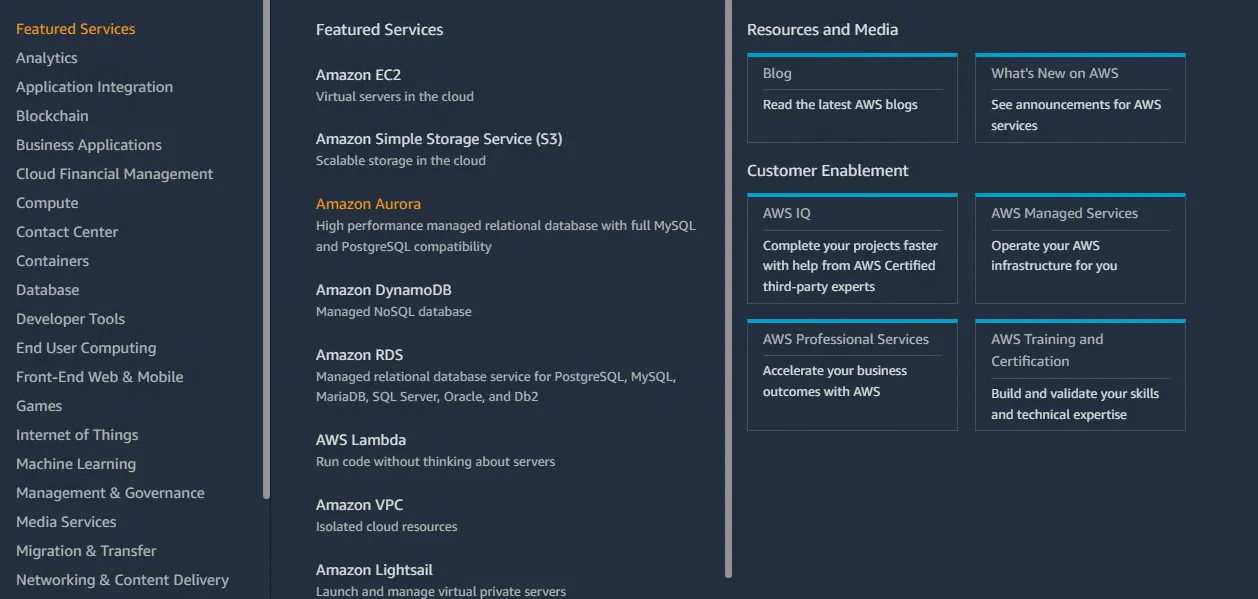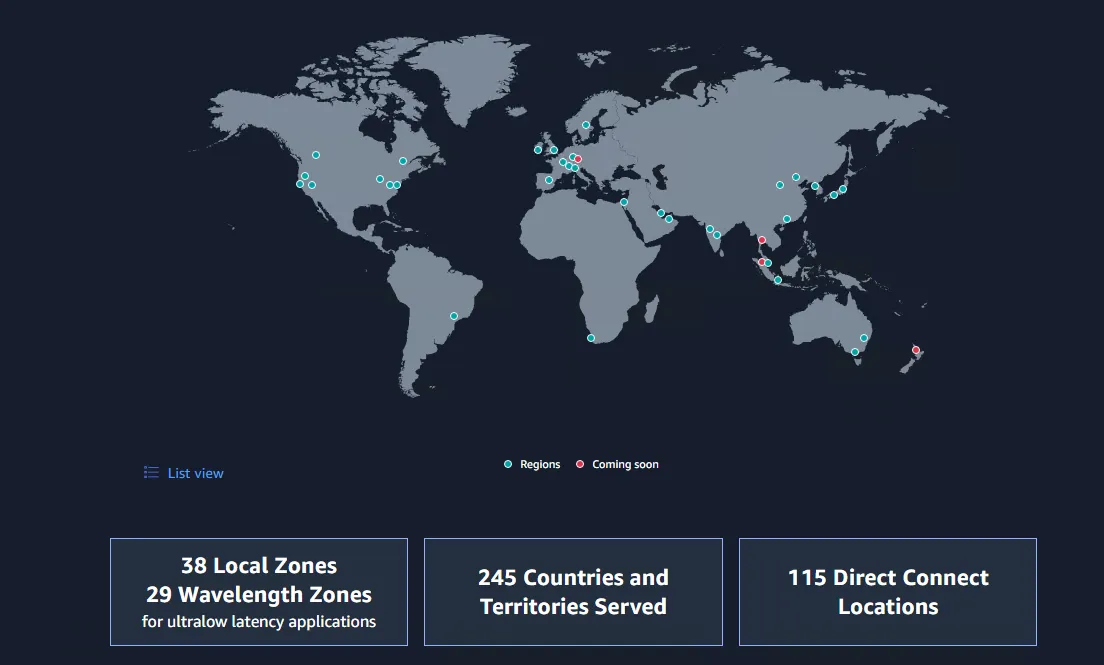Unlocking the Power of the Cloud: AWS Key concepts to know
Key concepts to understand AWS Cloud computing
Published Feb 8, 2024
Hello Cloud Learners,
Here is an interesting and beginner guide to understand the foundational concepts of AWS Cloud computing.
Let's focus some broad categories Compute, Network, Database, Storage etc,. and go through some important and key concepts to know when start learning AWS Cloud.

AWS operates the cloud infrastructure in 84 Availability Zones within 25 geographic Regions around the world with announced plans for 24 more Availability Zones and 9 more AWS Regions.
Enables innovation with reliable, low latency access allowing deployment of applications globally while meeting data residency needs.

Solution for the problem:
Meets data locality, compliance and low latency access needs globally. Enables disaster recovery across distinct geographic regions.
Top 3 Reasons to Use:
- Innovate globally with low latency access from anywhere in the world.
- Disaster recovery across distinct geographic regions along with availability/durability designs.
- Satisfy data residency, sovereignty or compliance requirements by country/region
EC2 provides scalable, on-demand compute capacity using virtual servers called EC2 instances to host applications.
EC2 enables companies and developers to rapidly spin up servers in minutes to deploy applications, greatly accelerating software delivery and business growth. It eliminates capacity planning and over provisioning of infrastructure as you can scale up or down based on real time compute requirements.
Solution for the problem:
EC2 solves complex infrastructure provisioning by automating procurement, setup and configuration of virtual servers. The pay-as-you-go pricing eliminates the need to accurately predict future infrastructure needs. Auto scaling and load balancing allows you to dynamically scale capacity based on utilization.
Top 3 Reasons to Use:
- Extremely flexible - Customize and control virtual server configurations for optimal price/performance via instance types.
- Scalable - Scale capacity and performance up or down in minutes when your needs change. Auto scale capacity to meet application demands.
- Cost-efficient - Eliminates large upfront capital expense for data centers. Pay only for the servers you use and keep running, reducing TCO by 70-90%.
S3 or Simple Storage Service provides highly durable, available and scalable object storage service to efficiently store and retrieve any amount of data.
S3 is revolutionizing storage by enabling cost-effective storage of high volumes of unstructured data. Its infinite scalability eliminates concerns around storage provisioning and increases business agility.
Solution for the problem:
Takes care of storage infrastructure management, capacity planning, backups, archival, disaster recovery. Provides virtually unlimited storage and eliminates constraints around rigid storage limits in data centers.
Top 3 Reasons to Use:
- Extreme durability and availability with 99.999999999% object persistence and 99.99% uptime SLA.
- Scalable to exabytes and unlimited transactions and bandwidth.
- Simple to use data storage with comprehensive access controls and integrations.
AWS Lambda lets you run code without thinking about or managing servers. It executes your backend code only when needed and scales automatically.
Enables innovation by eliminating undifferentiated work of infrastructure management. Allows focusing on code to solve business problems versus managing servers.
Solution for the problem:
Takes away the heavy lifting of provisioning, scaling and management of infrastructure and runtimes. Enables companies to focus innovation on the application layer and business logic versus the infrastructure layer.
Top 3 Reasons to Use:
- No servers to manage with continuous auto-scaling to meet traffic spikes.
- Consistent performance with millisecond scale execution.
- Pay per request pricing and free tier till 1M requests/month.
Amazon Virtual Private Cloud (VPC) provides a logically isolated virtual network to launch AWS resources in a private, isolated section of the AWS public cloud.
Enables creating virtual data center equivalents with full control over the virtual networking environment. This makes possible large scale migrations to the cloud.
Solution for the problem:
Provides ability to define network topology, IP address ranges, subnets, route tables, and gateways. Solves the need for network segmentation, security, and accounting separation between environments.
Top 3 Reasons to Use:
- Full control over virtual networking environment and ability to use both IPv4 and IPv6.
- Ability to create public facing subnets and place systems that need internet routing into the subnet.
- Integrated security and DDoS protection powered by AWS shield.
AWS IAM allows management of users, roles, permissions and API keys to access AWS services and resources in a programmatic and secure way.
Enables secure access at scale to shared cloud environments by customers, partners, and internal users while minimizing overhead.
Solution for the problem:
Solves the issues around securely sharing account credentials or keys to access cloud environments or resources. Removes dependency on emailing keys or passwords.
Top 3 Reasons to Use:
- Share access to AWS account and resources securely without sharing long term credentials.
- Granular permissions beyond physical infrastructure access controls.
- Integrate with corporate directories and SSO solutions for easier user management.
CloudFront is a content delivery network (CDN) that accelerates secure, global distribution of static, dynamic, streaming content using a global network of edge locations.
Makes possible next generation digital experiences by allowing latency sensitive, rich content delivery across the globe.
Solution for the problem:
Solves the problem of slow loading web sites or buffering of videos that frustrate users and hurt user experiences and conversion rates. Removes complexity in building infrastructure worldwide.
Top 3 Reasons to Use:
- Accelerates static and dynamic content delivery improving user QoE.
- Integrated with major third party CDNs and AWS services like S3, EC2, Lambda@Edge.
- Simple content upload, management and deployment APIs.
RDS provides managed deployment options for databases including Oracle, SQL Server, MySQL, MariaDB, and PostgreSQL database engines.
On-demand databases removing database administration overheads allowing innovation in apps and analytical workloads.
Solution for the problem:
Simplifies setup, operation, scaling, resilience and back up capabilities for production databases through automation. Allows focus on application innovation versus database infrastructure.
Top 3 Reasons to Use:
- Streamlined database provisioning and simplified administration.
- Flexibility to scale compute and storage up and down on demand.
- Built-in high availability and failover support.
Storage Gateway is a hybrid storage service to enable on-premises workloads to seamlessly use cloud storage. Supports tiering cold data to S3.
Allows businesses to leverage the scale, security and durability benefits of cloud storage for traditional, on-premise applications via hybrid deployments.
Solution for the problem:
Tackles challenges in integrating existing on-premise storage environments with cloud storage. Removes disruption and rearchitecting needs. Enables using S3 for backups.
Top 3 Reasons to Use:
- Use S3 for virtual tape library backups from on-prem workloads.
- Tier inactive data to S3 while retaining rapid access capabilities.
- Process tiered data directly using AWS compute services.
CloudTrail enables governance, compliance, and audit for AWS accounts by recording API calls made on the account and delivering the logs to user designated S3 buckets.
Provides unprecedented visibility into resource changes and user activity to meet security and compliance needs at scale.
Solution for the problem
Conforms to compliance standards for activity tracing, investigation and forensics. Allows visibility into who did what and when for resource troubleshooting.
Top 3 Reasons to Use:
- Log, monitor and retain account activity and API usage.
- Detect unusual activity indicative of security gaps or policy violations.
- Analyze resource changes and diagnose operational issues.
Hope this post given some basic understanding of key concepts about AWS cloud computing and connect with me on LinkedIn for more knowledge sharing.
Happy cloud journey !!!
